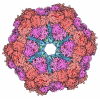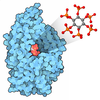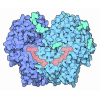[English] 日本語
 Yorodumi
Yorodumi- PDB-8ys2: Overall structure of Eastern Equine Encephalitis virus VLP in com... -
+ Open data
Open data
- Basic information
Basic information
| Entry | Database: PDB / ID: 8ys2 | ||||||||||||
|---|---|---|---|---|---|---|---|---|---|---|---|---|---|
| Title | Overall structure of Eastern Equine Encephalitis virus VLP in complex with the receptor VLDLR LA1-2 | ||||||||||||
 Components Components |
| ||||||||||||
 Keywords Keywords | VIRUS LIKE PARTICLE / Eastern Equine Encephalitis virus / EEEV / receptor / complex / VLDLR / glycoprotein / VIRAL PROTEIN | ||||||||||||
| Function / homology |  Function and homology information Function and homology informationreelin receptor activity / VLDL clearance / glycoprotein transport / very-low-density lipoprotein particle receptor activity / ventral spinal cord development / Reelin signalling pathway / very-low-density lipoprotein particle binding / low-density lipoprotein particle receptor activity / very-low-density lipoprotein particle clearance / togavirin ...reelin receptor activity / VLDL clearance / glycoprotein transport / very-low-density lipoprotein particle receptor activity / ventral spinal cord development / Reelin signalling pathway / very-low-density lipoprotein particle binding / low-density lipoprotein particle receptor activity / very-low-density lipoprotein particle clearance / togavirin / reelin-mediated signaling pathway / very-low-density lipoprotein particle / positive regulation of dendrite development / cargo receptor activity / T=4 icosahedral viral capsid / lipid transport / dendrite morphogenesis / regulation of synapse assembly / apolipoprotein binding / cholesterol metabolic process / clathrin-coated pit / receptor-mediated endocytosis / VLDLR internalisation and degradation / memory / calcium-dependent protein binding / nervous system development / symbiont-mediated suppression of host toll-like receptor signaling pathway / host cell cytoplasm / receptor complex / symbiont-mediated suppression of host gene expression / lysosomal membrane / serine-type endopeptidase activity / fusion of virus membrane with host endosome membrane / calcium ion binding / symbiont entry into host cell / virion attachment to host cell / host cell nucleus / host cell plasma membrane / glutamatergic synapse / virion membrane / structural molecule activity / signal transduction / proteolysis / RNA binding / membrane / plasma membrane Similarity search - Function | ||||||||||||
| Biological species |   Eastern equine encephalitis virus Eastern equine encephalitis virus Homo sapiens (human) Homo sapiens (human) | ||||||||||||
| Method | ELECTRON MICROSCOPY / single particle reconstruction / cryo EM / Resolution: 5.2 Å | ||||||||||||
 Authors Authors | Cao, D. / Ma, B. / Cao, Z. / Xu, X. / Zhang, X. / Xiang, Y. | ||||||||||||
| Funding support |  China, 3items China, 3items
| ||||||||||||
 Citation Citation |  Journal: Nat Commun / Year: 2024 Journal: Nat Commun / Year: 2024Title: The receptor VLDLR binds Eastern Equine Encephalitis virus through multiple distinct modes. Authors: Duanfang Cao / Bingting Ma / Ziyi Cao / Xiaoyu Xu / Xinzheng Zhang / Ye Xiang /  Abstract: Eastern Equine Encephalitis virus (EEEV) is an alphavirus that can cause severe diseases in infected humans. The very low-density lipoprotein receptor (VLDLR) was recently identified as a receptor of ...Eastern Equine Encephalitis virus (EEEV) is an alphavirus that can cause severe diseases in infected humans. The very low-density lipoprotein receptor (VLDLR) was recently identified as a receptor of EEEV. Herein, we performed cryo-electron microscopy structural and biochemistry studies on the specific interactions between EEEV and VLDLR. Our results show that VLDLR binds EEEV at three different sites A, B and C through its membrane-distal LDLR class A (LA) repeats. Site A is located in the cleft in between the E1-E2 heterodimers. Site B is located near the connecting β ribbon of E2 and is in proximity to site A, while site C is on the domain B of E2. The binding of VLDLR LAs to EEEV is in complex modes, including the LA1-2 and LA3-5 mediated two major modes. Disruption of the LA1-2 mediated binding significantly affect the cell attachment of EEEV. However, the mutation W132G of VLDLR impairs the binding of LA3, drives the switch of the binding modes, and significantly enhances the attachment of EEEV to the cell. The W132G variant of VLDLR could be identified in human genome and SNP sequences, implying that people with similar mutations in VLDLR may be highly susceptible to EEEV infection. | ||||||||||||
| History |
|
- Structure visualization
Structure visualization
| Structure viewer | Molecule:  Molmil Molmil Jmol/JSmol Jmol/JSmol |
|---|
- Downloads & links
Downloads & links
- Download
Download
| PDBx/mmCIF format |  8ys2.cif.gz 8ys2.cif.gz | 837.2 KB | Display |  PDBx/mmCIF format PDBx/mmCIF format |
|---|---|---|---|---|
| PDB format |  pdb8ys2.ent.gz pdb8ys2.ent.gz | Display |  PDB format PDB format | |
| PDBx/mmJSON format |  8ys2.json.gz 8ys2.json.gz | Tree view |  PDBx/mmJSON format PDBx/mmJSON format | |
| Others |  Other downloads Other downloads |
-Validation report
| Arichive directory |  https://data.pdbj.org/pub/pdb/validation_reports/ys/8ys2 https://data.pdbj.org/pub/pdb/validation_reports/ys/8ys2 ftp://data.pdbj.org/pub/pdb/validation_reports/ys/8ys2 ftp://data.pdbj.org/pub/pdb/validation_reports/ys/8ys2 | HTTPS FTP |
|---|
-Related structure data
| Related structure data |  38376MC 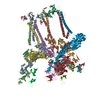 8xi4C 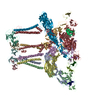 8xi5C 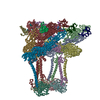 8ys4C M: map data used to model this data C: citing same article ( |
|---|---|
| Similar structure data | Similarity search - Function & homology  F&H Search F&H Search |
- Links
Links
- Assembly
Assembly
| Deposited unit | 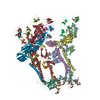
|
|---|---|
| 1 | x 60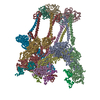
|
- Components
Components
| #1: Protein | Mass: 47984.246 Da / Num. of mol.: 4 Source method: isolated from a genetically manipulated source Source: (gene. exp.)   Eastern equine encephalitis virus / Production host: Eastern equine encephalitis virus / Production host:  Homo sapiens (human) / References: UniProt: Q4QXJ7 Homo sapiens (human) / References: UniProt: Q4QXJ7#2: Protein | Mass: 47047.020 Da / Num. of mol.: 4 Source method: isolated from a genetically manipulated source Source: (gene. exp.)   Eastern equine encephalitis virus / Production host: Eastern equine encephalitis virus / Production host:  Homo sapiens (human) / References: UniProt: Q4QXJ7 Homo sapiens (human) / References: UniProt: Q4QXJ7#3: Protein | Mass: 29178.846 Da / Num. of mol.: 4 / Mutation: K67N Source method: isolated from a genetically manipulated source Details: AAU95735.1 / Source: (gene. exp.)   Eastern equine encephalitis virus / Production host: Eastern equine encephalitis virus / Production host:  Homo sapiens (human) / References: UniProt: Q4QXJ7, togavirin Homo sapiens (human) / References: UniProt: Q4QXJ7, togavirin#4: Protein | Mass: 8854.691 Da / Num. of mol.: 4 Source method: isolated from a genetically manipulated source Source: (gene. exp.)  Homo sapiens (human) / Gene: VLDLR / Production host: Homo sapiens (human) / Gene: VLDLR / Production host:  Homo sapiens (human) / References: UniProt: P98155 Homo sapiens (human) / References: UniProt: P98155#5: Chemical | ChemComp-CA / Has ligand of interest | N | Has protein modification | Y | |
|---|
-Experimental details
-Experiment
| Experiment | Method: ELECTRON MICROSCOPY |
|---|---|
| EM experiment | Aggregation state: PARTICLE / 3D reconstruction method: single particle reconstruction |
- Sample preparation
Sample preparation
| Component | Name: Eastern equine encephalitis virus / Type: VIRUS Details: EEEV Virus like particle in complexed with its receptor VLDLR LA1-2 Entity ID: #1-#4 / Source: RECOMBINANT |
|---|---|
| Source (natural) | Organism:   Eastern equine encephalitis virus Eastern equine encephalitis virus |
| Source (recombinant) | Organism:  Homo sapiens (human) Homo sapiens (human) |
| Details of virus | Empty: YES / Enveloped: YES / Isolate: OTHER / Type: VIRUS-LIKE PARTICLE |
| Natural host | Organism: Eastern equine encephalitis virus |
| Buffer solution | pH: 8 |
| Specimen | Embedding applied: NO / Shadowing applied: NO / Staining applied: NO / Vitrification applied: YES |
| Vitrification | Cryogen name: ETHANE |
- Electron microscopy imaging
Electron microscopy imaging
| Experimental equipment |  Model: Titan Krios / Image courtesy: FEI Company |
|---|---|
| Microscopy | Model: FEI TITAN KRIOS |
| Electron gun | Electron source:  FIELD EMISSION GUN / Accelerating voltage: 300 kV / Illumination mode: FLOOD BEAM FIELD EMISSION GUN / Accelerating voltage: 300 kV / Illumination mode: FLOOD BEAM |
| Electron lens | Mode: BRIGHT FIELD / Nominal defocus max: 1700 nm / Nominal defocus min: 1200 nm |
| Image recording | Electron dose: 50 e/Å2 / Film or detector model: GATAN K2 SUMMIT (4k x 4k) |
- Processing
Processing
| EM software | Name: PHENIX / Category: model refinement | ||||||||||||||||||||||||
|---|---|---|---|---|---|---|---|---|---|---|---|---|---|---|---|---|---|---|---|---|---|---|---|---|---|
| CTF correction | Type: PHASE FLIPPING AND AMPLITUDE CORRECTION | ||||||||||||||||||||||||
| 3D reconstruction | Resolution: 5.2 Å / Resolution method: FSC 0.143 CUT-OFF / Num. of particles: 15654 / Symmetry type: POINT | ||||||||||||||||||||||||
| Refine LS restraints |
|
 Movie
Movie Controller
Controller












 PDBj
PDBj
